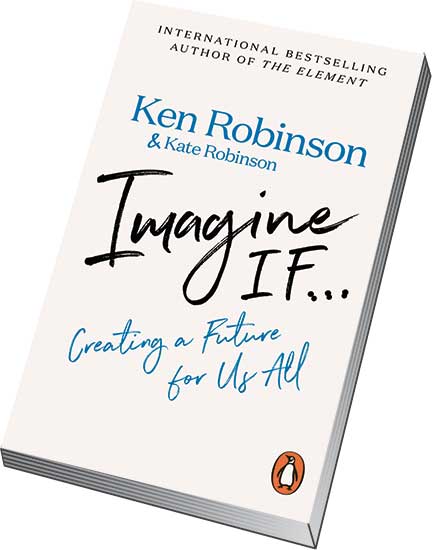Chintan Girish Modi
“Opportunities for change exist within every school. Schools often do things simply because they’ve always done them that way, but many of these habits are not mandated. The best place to start thinking about how to change education is exactly where you are in it.”
How do these words from Sir Ken Robinson and Kate Robinson’s book Imagine If… speak to you? Do they make you feel responsible, scared, empowered or implicated? How you receive them might have to do with your experience of being a teacher, shaped by the systems that you work within but also your beliefs about education, schools, and what learning entails.

Sir Ken Robinson was a professor of education at the University of Warwick in the United Kingdom until he passed away in 2020. His ideas about creativity, innovation and human potential have circulated widely thanks to his TED talk titled “Do Schools Kill Creativity?” and his report titled “All Our Futures: Creativity, Culture and Education”. This book is meant to be a concise introduction to his key ideas and propositions, developed over a lifetime.
His daughter, Kate Robinson, is a writer and speaker who runs the SKR Legacy Collective Fund and the non-profit called Imagine If… that gives this book its title. She describes her father’s work as “a deep criticism of the many systems that we have come to take for granted” and also “a love letter to human potential”. Drawing inspiration from his work, she is now involved in projects that are related to education, environment, and culture.
This book is divided into eight chapters: 1. The Human Advantage 2. The World We Have Created 3. You’re More Than You Think 4. The Promise of Education 5. From the Factory to the Farm 6. Creating Miracles 7. One Shot 8. Be the Change. It can be read from start to finish in just a day. But, you could also read a chapter at a time, reflect and journal about it. If your school has a weekly or monthly reflection meeting that is meant for professional development, you might want to consider using a few excerpts from this book to focus on.

Authors: Ken Robinson and Kate Robinson
Publisher: Penguin Books
Year of publication: 2022
Number of pages: 144
Price: UK £9.99
Imagine If… is worth reading because it does not shy away from calling out what ails the contemporary education system. At the same time, it does so with love and not bitterness. It does not paint an unredeemable picture. It gives a reality check, but it also provides hope. It reassures teachers that they matter, and so does their work; that they can change the system simply by changing “the experiences of education” for the students whom they work with.
This book is a plea for teachers to bolster children, not demoralize them. It asks teachers to honour “the marvellous diversity of young people’s talents and interests”, and not reduce education to “narrow forms of academic ability”. It offers a blueprint for course correction, and imagination is at the centre of it. In this book, imagination is defined as “the ability to bring to mind things that are not present to our senses”, and it is supported by creativity that is defined as “the process of putting your imagination to work”. In other words, imagination helps us think of alternative possibilities, and creativity gives us the tools to realize them.
Here are some ideas to take away from the book and apply to your context:
- Look beyond standardized testing.
Amidst the pressures of assessment, it can be hard to remember that “all children are born with vast potential” and that the purpose of education is to help them “flourish in both worlds, outer and inner.” This book will remind you that the stress caused by standardized testing is pushing students to suicide, so that you do not lose sight of the big picture. The intent behind assessment is to get a picture of what students have learnt, where they are struggling, and the kind of support they need. Their interests and strengths need to be understood; else assessment will be an emotional ordeal and an administrative nightmare. - Engage with local communities.
Do you think of parent-teacher meetings as necessarily evils or do you look forward to them? Imagine If… points out that “parent and caregiver participation” is a vital resource that schools must tap into so that learning opportunities respond to who children are and where they live. The authors suggest that problems related to bullying and discipline that occur in the classroom or as part of other spaces on campus often begin in the world outside school. They recommend developing closer ties with families because learning does not take place in isolation for those who come to school. They are initiated into their culture at home. - Be thoughtful about the physical environment.
Light, temperature, air quality, furniture and so many other aspects of the physical environment affect the mood and motivation of children who go to school. Do you and your colleagues think about whether the children have enough space to move around, if the environment inspires confidence or dread, whether the chairs that they are sit in for hours on end are comfortable enough, if the light in their classroom is adequate to help them be attentive? Is it possible to redesign some of the spaces, in consultation with children to break the monotony and also to get them to reflect on how spaces contribute to learning? Thankfully, the authors are aware that schools are constrained by the resources at hand. - Prepare students for the changing economic landscape.
While learning can be enjoyed for its own sake, a large number of parents send their children to school because they want a higher standard of living for the next generation. This book proposes that schools must “connect students with their unique talents and interests, dissolve the division between academic and vocational programmes, and foster practical partnerships between schools and the world of work”. The rationale is that education should empower students to be economically responsible and independent. When the job market is changing so rapidly due to advances in technology and other spheres of life the children need more than bookish learning. They need to experience working environments as part of their education and need to learn to adapt to new scenarios. - Make room for play.
Teachers often worry about how today’s children are losing out on their childhood but they also feel a bit helpless when it comes to addressing this. The authors of this book drive home the point that play should not be seen as a waste of time; it is part of how children learn. They advise schools to “stand aside and let it happen” because “children do not need lessons in how to play, nor do they need to overly surveilled or scheduled…they simply require the space and freedom to do what they naturally do best.” Getting out of the way is difficult for teachers, and this is partly understandable because bullying often happens during playtime.
As you mull over these ideas, it might be helpful to watch the questions and doubts that arise, and note down the exciting possibilities that bubble up in your mind so that you can share them with your colleagues, your students and their parents to imagine the kind of school that all of you would not only love to come to but also create together; slowly and lovingly.
The author is a bibliophile, journalist, and educator based in Mumbai. He can be reached at chintan.writing@gmail.com.
